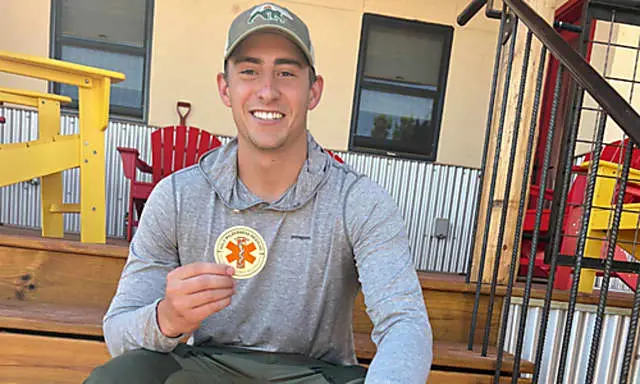[ad_1]
In late July of last year, as night fell over the Housekeeping Camp in Yosemite National Park, Kathi Andrews and her grandsons returned from the restrooms to their cabin. Andrews was just about to climb into bed, when she heard “the most tremendous cracking and crashing sound.”
“I actually put my hands up over my head because the sound was so near,” Andrews told SFGATE. “I heard screams from the other campers.”
Andrews lives in Oklahoma but has been camping with her family in Yosemite National Park nearly every summer since 1964. Her father first brought her when she was 5, and she carried on the tradition with her husband and their four children, who now bring their own children on the yearly expeditions.
The family has stayed in tents, trailers, cabins and lodges across the park, and hiked all of the popular trails. But Andrews had never heard anything like that cracking sound.
She grabbed her flashlight and rushed outside, where other campers were gathering to figure out what happened. On the path that led back toward the bathroom, her flashlight illuminated a massive branch, completely blocking the area where she had walked with her grandsons just minutes before. Shining a flashlight up a nearby oak tree, Andrews could see where the branch had broken free.
“It was incredible!” she said. “In the morning, the enormity of our close call took my breath away.”

A black oak tree and its fallen limb, from Cook’s Meadow, in Yosemite National Park.
National Park ServiceWhen these incidents happen in Yosemite National Park, visitors who survive them may feel that something unusual has taken place, something extremely unlucky. But actually, rangers are not surprised by such events.
They even have a name for them, along with an acronym: SBD. Summer branch drop — and climate change could be exacerbating the situation.
SBD occurs when seemingly healthy trees suddenly lose large branches without warning, according to the park’s website. It tends to happen on warm summer days, and although SBD can happen with any type of tree, in Yosemite, the black oaks are particularly susceptible.
“Cooling off underneath an oak tree is one of the greatest pleasures after a long trek in the summer sun. However, a delightful picnic or siesta in the shade can be dangerously disrupted by summer branch drop,” a Yosemite staff member recently posted on Facebook as a safety reminder. “Generally, it is a good idea to avoid sitting or setting up a tent directly underneath large oak branches. Be aware of your surroundings and do not leave immobile people, such as infants or the elderly, directly under large oak trees. If you hear a loud crack from a tree, quickly get away from the area.”
The Facebook post drew comments from dozens of Yosemite enthusiasts, and some — including Andrews — shared their own stories or those of people they knew. One user wrote that she became a victim of SBD last July, when a large pine tree branch fell and fractured her arm in the Wawona area of the park. Another commenter, Marguerite Syvertson, wrote that her high school classmate Greta Breedlove had been involved in a tragic accident.
“She and her husband were on their honeymoon in Yosemite when a branch fell on their tram and killed them both,” Syvertson told SFGATE. About 20 other people were injured in the incident, during which a 6,000-pound oak branch fell 30 feet into an open-air tram, according to the book “” by Michael Ghiglieri.
Breedlove had been a student at UC Davis at the time, Syvertson said, and there is a bench near the freshman dormitories dedicated to her memory. Syvertson’s son goes to UC Davis, and she has visited the bench.
More recently, there have been additional injuries and deaths related to SBD.

Mason Kropp rests in his hammock Aug. 15, 2015, directly across from where park officials say an oak tree limb fell on a tent in the heart of Yosemite National Park, killing two young campers.
Barbara Davidson/Los Angeles Times via Getty ImagIn 1992, a tour bus was stopped along the Merced River so that the passengers could view Yosemite Falls. As a tour guide spoke, an oak branch fell from above and injured seven people.
In 2012, concessions worker Ryan Hiller, 27, was inside his tent cabin during a windstorm when a tree limb fell on it, killing him.
In August of 2015, high school students Dragon Kim and Justin Lee were sleeping in a tent within the Upper Pines Campground in Yosemite Valley, a popular spot for families. An oak limb fell on the tent at about 4:15 a.m., killing them both. Park officials said it hadn’t been windy that morning, and it was unclear why the limb fell.
“Fallen branches like this one are a common occurrence across the park,” Yosemite National Park spokesperson Scott Gediman told the Los Angeles Times. In response to an inquiry from SFGATE about how frequently people are injured and killed by falling branches within the park, Gediman said the park does not track injuries and fatalities based on type or location, nor does it keep stats on falling branches.
Gediman did provide some insight into why branches may be falling, although SBD is not fully understood by scientists. “With drought conditions, there is certainly less moisture in the trees, which could be a contributing factor,” Gediman wrote in an email.

New leaves grow on an oak tree in Yosemite National Park.
Ted Soqui/Corbis via Getty ImagesYears of drought conditions have had a severe impact on Yosemite’s trees, and some scientists believe that a lack of water could be an underlying cause for tree branches suddenly snapping off. Others believe internal cracks caused by wounds, age or stress might be to blame, but no one knows for sure.
What’s clear is that the stress of climate change is taking a toll. Extreme storms, warming temperatures, drought, disease and insects are killing trees all over the park. At last count, in 2017, officials found 2.4 million dead trees over just 131,000 acres — the most dead trees ever counted in the park.
According to Yosemite’s website, the National Park Service has increased staff for identifying and removing hazardous trees. Since 2016, more than 5,000 trees posing risks to life or infrastructure have been removed each year from campgrounds, picnic grounds, roadsides and housing areas. It’s not possible to prevent SBD, of course, since the trees appear healthy.
For Andrews and millions of other visitors, of course, the threat of SBD is not about to stop them from spending time in the park. In fact, Andrews’ yearly family trip is coming up in late August. She does, however, have a plan for avoiding SBD.
“You better believe that when we camp in Yosemite next week, we will be steering clear of oak trees,” she said.
[ad_2]
Source link





